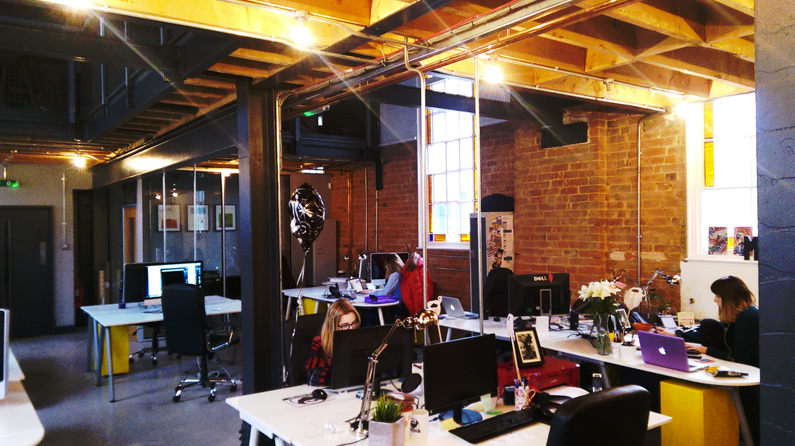Are apprentice schemes good for the design industry?
Digital director Sush Kelly looks at design apprenticeships from an agency and student's perspective.

With the costs of doing a degree ever-growing and student debt the highest it's ever been, it could be time to consider an apprenticeship as your way into the design industry. But is it good for you, agencies and the industry as a whole?
Last week our company made the decision to create two apprenticeship placements. It wasn't a spur of the moment thing, we have been discussing how the company could grow and since moving into a much larger studio right in the heart of Leamington Spa we now had the space to put some plans into place.
Creative Alliance
Had it not been for my new train journey to work, it's unlikely that I'd have stumbled upon the Creative Alliance (a partner of the IPA Creative Pioneers scheme) whilst flicking through the free Metro paper. The Creative Alliance help to bring together people looking to get into the design industry, with companies wanting to nurture fresh talent inhouse.
It felt like it was meant to be, although having always associated apprenticeships with trades such as plumbers, electricians and mechanics, I'd never really considered how the format would work in something like a creative agency. We decided to advertise for a graphic designer and a front end dev role, so worked up the relevant descriptions and opted to set a price point above the base apprentice wage.
As the adverts went onto the scheme's website we thought it a good idea to share via Twitter and Facebook ourselves to try and increase the chances of that special someone stumbling across it.
What I wasn't expecting was a negative reaction from people.
"£3.50 an hour? OUCH!"
Daily design news, reviews, how-tos and more, as picked by the editors.
"It's asking them to create new graphics, develop ideas and add creative input! 140 a week for 40 hours, duuuuuddeeee."
There were positive comments too but I was surprised that anyone would perceive it as a bad thing. It started a debate in the studio about how relevant people had thought their degree was.

So what's good?
It's an alternative to doing a degree, and although the remuneration is low compared to even a junior role it must be remembered that the person is coming on board without qualifications. It's working from the bottom up within a well established creative agency so it's a positive learning experience with a view to you growing within the company into higher roles.
Of course, it's important for an apprentice to get involved, to learn, test their limits and develop themselves as designers. There's no point getting someone in to sit, be bored and simply make tea! It's also a chance for someone to get some all-important commercial experience, as well as some high profile client work in their portfolio.
For the employer there is the opportunity to unearth a special talent of course, but more importantly it gives them the chance to give a little back to next generation of designers/developers, add some fresh ideas, enthusiasm and ultimately fun into their company.
And the bad?
You won't be getting a formal degree if you get into work through the apprentice route. This probably won't be a problem if you stay within design and development as your experience within the industry will count for more than a degree as you move your way up. But if you moved into a different sector you may be marked down for the lack of formal qualification.
The money isn't great initially, but then you don't get paid to go to college. It's training on the job and, as such, it might be best to think of it more like further education than a badly paid job.

University also offers other experiences that you won't have by diving straight into work. Spreading your wings and living together with new people are arguably as important in your 'life education' as the degree you choose.
From an employers point of view, full training needs to be given to the apprentice which will mean that fee paying staff will be spending time training and not earning. You will need to devote time to them taking in the surrounding principles of design, not just teaching them Illustrator.
Right here… right now?
Another thing to think about is the speed that skill sets and whole job roles are developing and changing within the industry compared to what is actually taught at college. Will the skills you learn in your first year at college have much bearing three years later when you are searching?
Without doubt there are core skills and principles that make a degree a great idea, but generally schools and colleges start implementing programmes and languages into their syllabus once they become a standard, the problem that exists, especially in the web industry where the standards are ever changing.
Which is most likely to get me a job?
According to HESA statistics around 86 per cent of people studying Creative Arts and Design go on to employment after their degree so I asked Noel Dunne at Creative Alliance what the success levels were with apprentices.
"After 12 months as a creative apprentice, 85 per cent of those who complete their design and digital media apprenticeship move into full time employment, most with their sponsoring employer, earning at least and usually more than minimum wage."
According to HESA statistics around 86 per cent of people studying Creative Arts and Design go on to employment
Arguably a more affordable route into the industry from the point of view of the apprentice. He went on: "They've made an investment in their future. Their employer has made an investment in them. It's not better than traditional academic entry routes into the sector, just another alternative for those young people who learn better by doing and for those employers who prefer to develop talent inhouse."
With the statistics speaking for themselves, evidently both pathways offer a similar success rate, but for students who have traditionally struggled in an academic environment apprenticeships provide a viable alternative to getting into the industry.
It's essential though, that the employer already has a good foundation and set of skills within the company. If this is the case then developing new positions in house makes great sense as the apprentice will develop the same ethos and skills sets.
Follow the white rabbit
Whether you decide to take the formal university route or jump straight into work as an apprentice, you'll still have to develop client skills and gain some commercial experience.
It's not quite as important a choice as when Morpheus offers to show Neo a different way in The Matrix, but, whichever way you choose to go, the design industry as a whole is ready and waiting for you... Will it be the red pill or the blue pill, Neo?
Words: Sush Kelly
Sush Kelly is Digital Director at Imaginate Creative Ltd, a creative agency in Leamington Spa.
Like this? Read these!
- The designer's guide to working from home
- How to build an app: try these great tutorials
- Free graphic design software available to you right now!

The Creative Bloq team is made up of a group of art and design enthusiasts, and has changed and evolved since Creative Bloq began back in 2012. The current website team consists of eight full-time members of staff: Editor Georgia Coggan, Deputy Editor Rosie Hilder, Ecommerce Editor Beren Neale, Senior News Editor Daniel Piper, Editor, Digital Art and 3D Ian Dean, Tech Reviews Editor Erlingur Einarsson, Ecommerce Writer Beth Nicholls and Staff Writer Natalie Fear, as well as a roster of freelancers from around the world. The ImagineFX magazine team also pitch in, ensuring that content from leading digital art publication ImagineFX is represented on Creative Bloq.
